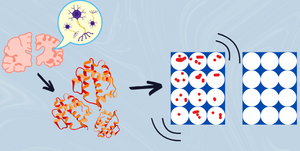
Neurodegenerative diseases, such as Parkinson’s, often begin decades before clinical symptoms are observed. Early detection is crucial, but identifying disease biomarkers - like the low concentrations of α-synuclein aggregates - is incredibly challenging. In a study published in Angewandte Chemie, Azad Farzadfard and colleagues explore how to facilitate the detection of small amounts of these aggregates in biological samples. They achieved higher sensitivity by modifying the prion disease seed aggregation assay into a more sensitive microemulsion seed aggregation assay (SAA). By using Amytracker, the researchers confirmed that under fully quiescent conditions, α-synuclein amyloid fibril amplification was suppressed in the microemulsion SAA. This finding highlights that mechanical energy, rather than passive conditions, plays a key role in driving the pathogenic aggregation process, opening up new possibilities for early diagnosis and intervention.
Image: Detecting small amounts of α-synuclein aggregates in cerebrospinal fluid could significantly improve early diagnosis of Parkinson's disease. However, doing so within microemulsion droplets is difficult, since the fully quiescent conditions inside them tend to inhibit fibril growth through fragmentation and secondary nucleation. One effective solution is to use ultrasonic agitation, which enables reliable amplification - and thus detection - of both pre-formed seeds and those derived from Parkinson’s disease brain samples.
